Want cleaner aquarium water and a touch of green beauty? Let me introduce you to a game-changing houseplant: Pothos. Yes, that trailing vine you see in homes everywhere also happens to work wonders in a fish tank!
In this guide, I’ll walk you through how to use pothos in aquariums, what to expect, and how to balance it with your aquatic plants and fish. I’ll share my own experience, answer common concerns, and help you decide if this popular houseplant deserves a place in your tank.
Why Put Pothos in a Fish Tank?
Pothos (Epipremnum aureum) is a hardy, fast-growing vine known for its air-purifying abilities in homes. But in aquariums, it serves another fantastic role: natural water filtration.
When placed in a tank, pothos:
- Absorbs nitrates, ammonia, and other waste byproducts.
- Grows fast (especially with free access to CO₂ from the air).
- Helps control algae by outcompeting it for nutrients.
- Looks absolutely stunning with its cascading vines.
How to Grow Pothos in an Aquarium (Step-by-Step)
Good news: You don’t need soil or even a pot. Here’s how I (and many aquarium enthusiasts) grow pothos successfully in a tank.
What You Need:
- A cutting of pothos (about 4–6 inches long)
- A freshwater tank (no saltwater!)
- A place to rest the stem above water and let roots dangle into the tank
- Optional: suction cup holder, foam ring, or hole in the aquarium lid
Steps:
- Take a healthy cutting with at least 2–3 leaves.
- Remove the lower leaves so the stem can go into the water without rotting.
- Place the cut end into the tank, making sure only the roots are submerged.
- Keep the leaves above water, exposed to light and air.
- Within a few weeks, roots will grow long and feathery.
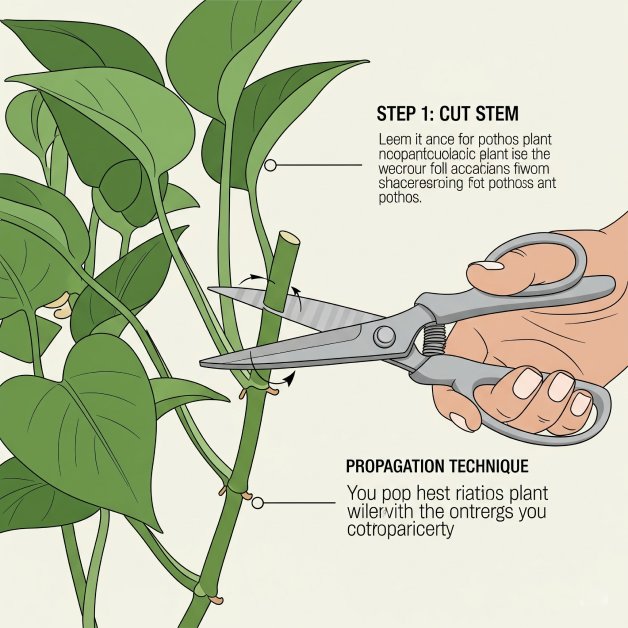
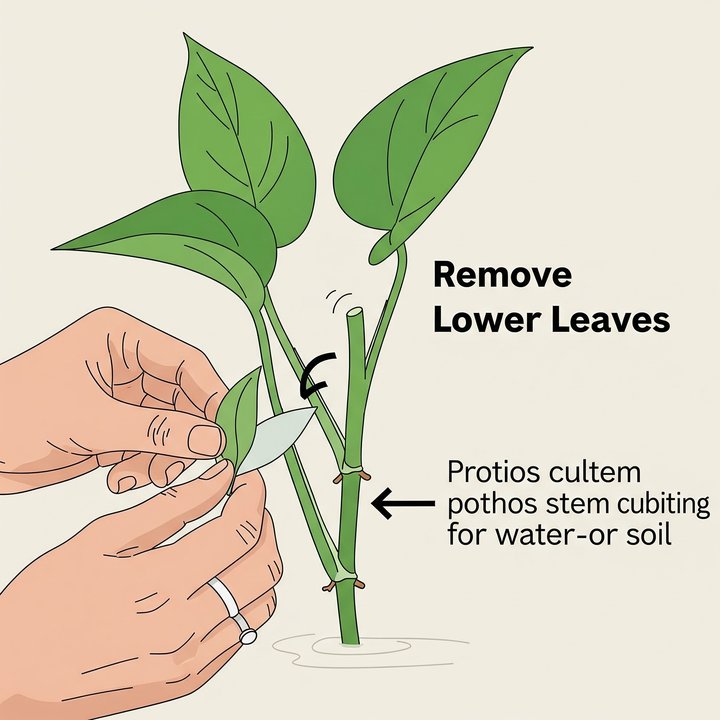

My Tip: Use a suction cup clip or rest the cutting in a filter compartment so it doesn’t float around. Some even punch a hole in the aquarium lid.
The Science: What Pothos Does in a Tank
Fish and plant waste release ammonia. This turns into nitrites, and then into nitrates — which, in high amounts, stress or kill fish.
Pothos roots absorb these:
- Ammonia (in small amounts)
- Nitrites and nitrates
- Some phosphates
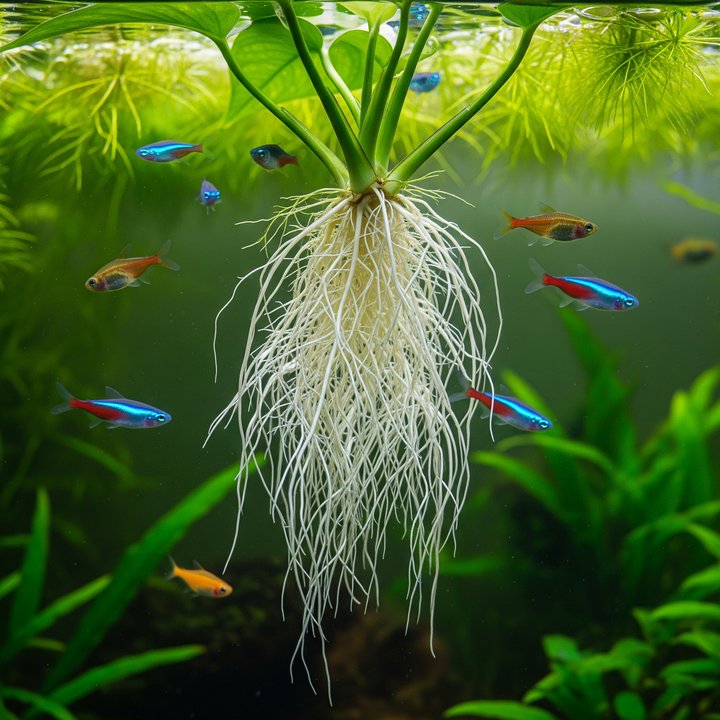
By doing so, pothos improves water quality and reduces how often you need water changes.
“I rarely touch the pothos roots. Everything is thriving. I rarely have to do water changes.” – Reddit user u/shrimperialist
My Experience with Pothos in Aquariums
I first tried pothos in my 20-gallon tank when battling algae blooms. A friend said, “Just throw in a pothos cutting and watch the magic.” Honestly? I was skeptical.
But two months later:
- My water readings stabilized.
- I had less green algae on the glass.
- The pothos had tripled in size, with roots over a foot long!
Now, I give my plant a “root haircut” every 2–3 months, trimming just enough to stop it from reaching the substrate.

Will Pothos Compete with Other Aquarium Plants?
Yes—but it’s all about balance.
Pothos has access to atmospheric CO₂, unlike submerged plants. This gives it a huge advantage. It grows fast and can outcompete slower growers like:
- Crypts
- Java fern
- Anubias
- Pearl weed
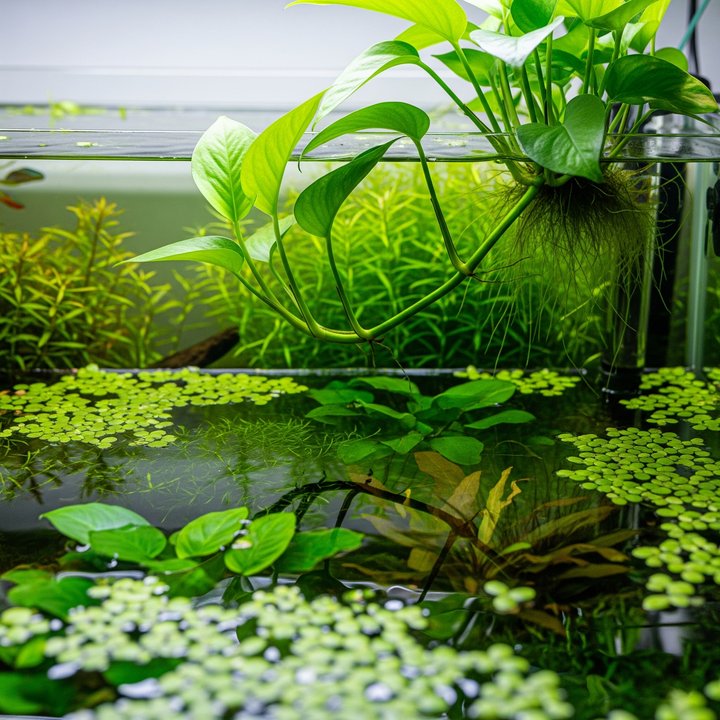
But that doesn’t mean you can’t use both! Many aquarists (me included) successfully grow pothos with other aquatic plants.
“I have pothos plus Anubias, Buce, dwarf hairgrass, and more. Everything thrives together.” – Reddit user u/shrimperialist
Tips for Balance:
- Trim pothos roots monthly.
- Increase fertilization (like Easy Green) to support submerged plants.
- Keep pothos in low-light zones if you want your underwater plants to dominate.
Is Pothos Safe for Fish?
Yes, but let’s break it down:
Safe for:
- Bettas
- Guppies
- Shrimp
- Tetras
- Most freshwater species
But:
- Leaves are toxic to fish if eaten. Keep leaves above the waterline.
- Don’t let fish chew or get stuck in dense root balls.
- Roots may need occasional pruning to avoid oxygen flow issues.
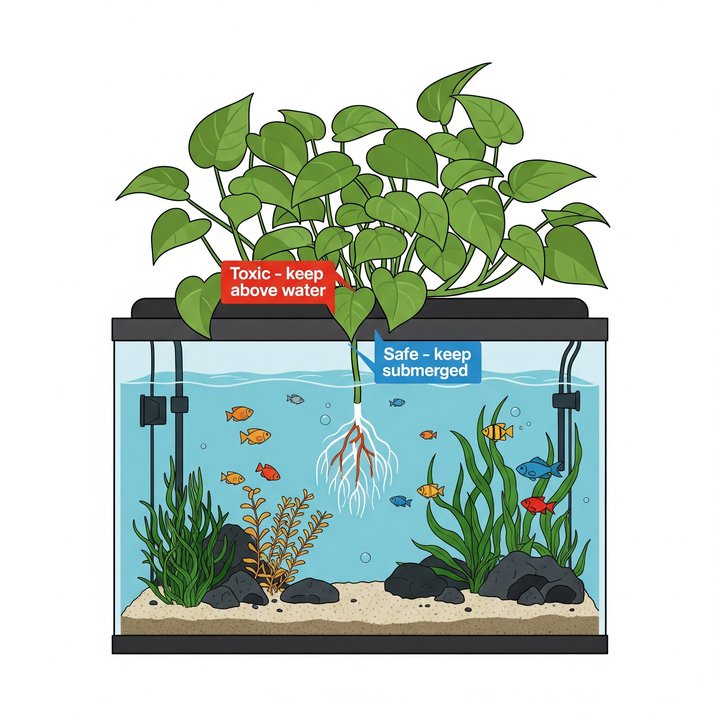
“Are pothos leaves toxic to fish?”
Yes, the leaves contain calcium oxalate crystals, which are mildly toxic. But as long as they stay out of the water, your fish are safe.
Pro Tips for Pothos Aquarium Care
Here are some tips I wish I knew earlier:
Do:
- Use indirect light or tank lighting.
- Trim roots often.
- Remove any rotting stems or leaves.
- Watch for yellowing (could mean root rot or low nutrients).
Don’t:
- Submerge leaves or stem nodes—this leads to rot.
- Let roots grow into filters or block flow.
- Rely on pothos alone for filtration in a high-bio-load tank.
Common Problems & Fixes
| Problem | Cause | Fix |
| Leaves turning yellow | Too much water on stem | Keep leaves dry, stem above water |
| No root growth | Not enough light | Place in brighter area |
| Submerged plants struggling | Nutrient competition | Trim pothos, boost fertilizers |
| Roots taking over | Rapid growth | Monthly trimming |
| Fish nibbling roots | Curious fish | Add floating plants as distraction |
FAQ: People Also Ask
Are pothos leaves toxic to fish?
Yes, the leaves are mildly toxic due to calcium oxalate. Always keep them above water to avoid harm.
Can pothos survive in water?
Absolutely. In fact, pothos thrives in water as long as the stem and leaves stay dry.
How to keep pothos alive in an aquarium?
Keep the roots in the water, trim them regularly, provide moderate light, and avoid submerging the stem or leaves.
Do pothos reduce nitrates?
Yes! Pothos is one of the best natural nitrate absorbers. It helps maintain healthy water parameters and reduce algae.
Final Thoughts
Pothos is more than just a pretty vine—it’s a powerful, natural filter that can bring balance to your aquarium. Whether you’re a beginner or a seasoned aquascaper, adding pothos can simplify your tank care and improve your fish’s health.
Just remember:
- Keep the roots in, leaves out.
- Observe, trim, and balance.
- And enjoy watching your underwater and overwater worlds thrive together.
Have you tried growing pothos in your fish tank? Let me know how it worked for you—drop a comment below!
